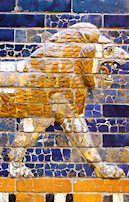| Go to Procursus, Chapter 5, 7, 9 |
|

E. A. Wallace Budge (1857-1934) held the position of Keeper of the Department of Egyptian and Assyrian Antiquities at the British Museum and was one of the best known Near Eastern archaeologists and translators of the turn of the last century. He directed multiple archaeological expeditions, and published a great many books and articles, both for a specialist audience and for the lay public.
Inspired by the enormous progress that had been made throughout the 1800s in the interpretation of ancient scripts and decipherment of the underlying languages, Budge believed that there was no reason why schoolboys, who already studied Latin and Greek, couldn't equally well master Egyptian if they wished to do so, or why lay readers couldn't become interested in cuneiform. He also believed that including words and passages in their original languages kept him honest as a translator, as we should say today. It is not surprising that he produced an Egyptian dictionary in the course of things, or that his translations of Egyptian and Mesopotamian texts are a nightmare for typesetters and computer coders.
Budge's vast academic output impressed his contemporaries and was a critical influence on public understanding of the peoples of the ancient Near East, who were known to most of his readers largely from accounts in the Bible. It was perhaps inevitable, given the pace and scale of his activity, that he should have been suspected of frequent low-level errors, or even that these suspicions should have been correct some of the time. But he was nevertheless honored even by his sharpest critics, and was knighted in 1920.
The chapters presented here (from the 1925 revision of the original 1883 edition) provide an overview of the two major documentary works that are most often discussed from ancient Mesopotamia: the Epic of Gilgamesh (chapter 5), considered by many to be a masterwork of world literature, and the legal code of Hammurabi (chapter 7), one of the earliest attempts to create codified legal standards.
Also included is chapter 9, a concise and useful reconstruction of Mesopotamian life, but a poorly organized one, and one sadly lacking in any explanation of the evidence on which it is based. Occasional references to the legal codes are made, and it appears that the study of a wealth of commercial contracts and other tablet evidence also lie behind it. But much of the reconstruction is difficult to document from texts or archaeology — especially at the time it was written — and Budge has little sense of controlled ethnographic analogy of a kind so important to modern archaeologists. For all that, it is an overview by a very knowledgeable scholar, and one can learn much from it.
Budge's paragraphs are extremely long even by the standard of his era. Accordingly the original paragraphs of each chapter have been numbered and serve as chapter sub-divisions, while paragraph divisions have been freely added throughout the text to facilitate on-screen reading. In one or two cases a subtitle has been added for the same reason. In the retelling of ancient tales, I have set the major dramatis personae in bold face. Certain spellings have changed from Budge's time to our own. Here I have retained his spellings (Gilgamish for the more modern Gilgamesh, and so on). The single exception has been changing his "Khammurabi" to the now universal spelling "Hammurabi."
If you would like to read the full book, it has been inexpensively reprinted (with a new introduction by Magnus Widell) as part of the Barnes and Noble Library of Essential Reading, ISBN: 978-0-7607-6549-4.
If you would like to hear a bit of the famous "flood story" discussed in chapter 5 read out loud in reconstructed pronunciation, click here for a BBC sound file. (Caution: slow download.)
Interactive review questions are available covering this procursus and chapter 5. You can attempt them in a series of three "wimp" quizzes (1, 2, 3), or a pair of "normal" quizzes (1, 2), or a single hero version.
Return to top.
Go to Chapter
5,
7,
9